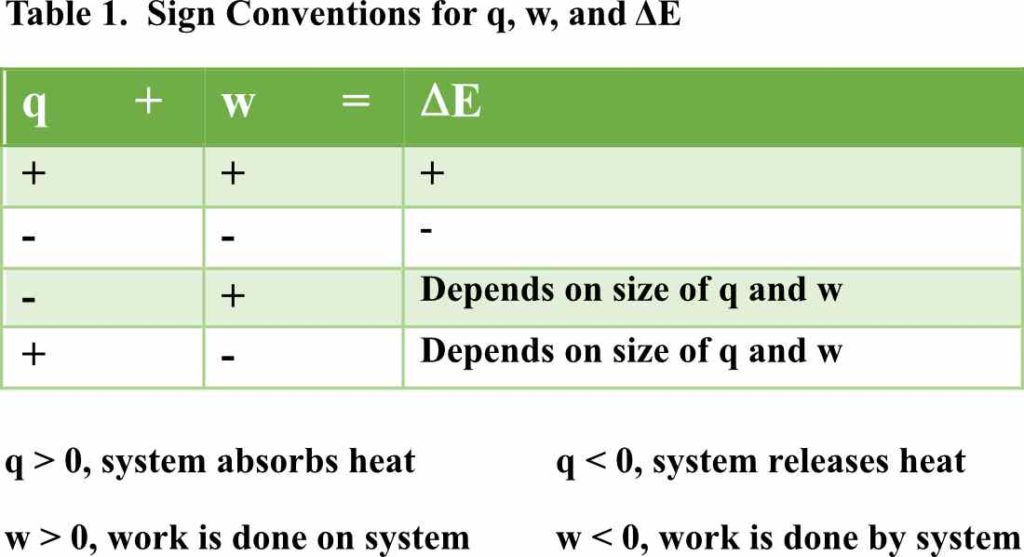Two forms of energy transfer are heat and work. Heat (thermal energy), q is the energy that flows into or out of a system because of the difference in temperature between the system and the surroundings. Work, w, is the energy transferred when an object is moved by a force. The internal energy change, ΔE, of a system is equal to the sum of the heat, q, and the work, w.
The value of ΔE can be positive or negative, and it is dependent on the signs of q and w. If energy is transferred into the system, the values are positive. If thermal energy (heat) is transferred out of the system, the value of q is negative. If work is done by the system on the surroundings, the value of w is negative. The value of q is positive if the system absorbs heat from the surroundings, and the value of w is positive if the surroundings does work on the system.
When energy is transferred only as heat, w = 0, and ΔE = q + 0, and ΔE = q. If heat flows out of the system to the surroundings, then q is negative and ΔE is also negative, ΔE < 0. If heat flows into the system from the surroundings, then q is positive, and ΔE is positive, and ΔE > o.
In the case where energy is transferred as work only, then q = 0, and ΔE = 0 + w, and ΔE = w. If work is done by the system, energy is transferred as work done by the system on the surroundings. The energy is releases as work and w < o, and ΔE < 0. If work is done on the system, energy is transferred as work done by the surroundings on the system and w > 0, and ΔE > 0. See the following table for the sign conventions for q, w, and ΔE.
Law of Energy Conservation: The First Law of Thermodynamics
The energy transferred between the system and the surroundings can be in the form of heat and/or various types of work. Types of work include mechanical, electrical, radiant, chemical work, etc. The first law of thermodynamics states that:
Energy is conserved.
This means the total energy of a system plus the surroundings remains constant. The total energy of the universe is constant.
The energy of the universe, ΔEuniverse, is equal to the sum of the energy of the system, ΔEsystem, and the energy of the surroundings, ΔEsurroundings. The sum is equal to 0, and energy is conserved.
Worksheet: First Law of Thermodynamics
Worksheet: Energy, Heat, and Work
Exercises
Exercises 1. What is the change in internal energy, ΔE, in joules, of a system that releases 856 J of thermal energy to the surroundings and has 675 calories of work done on it?
Check Answers/Solutions to Exercise 1
Exercises 2. Consider the following combustion reaction:
C2H2 (g) + 5/2 O2 (g) → H2O (g) + 2 CO2 (g)
If 1256 kJ of heat is released, what is the sign and value of q? Assuming the work done is 3716 J, what is the sign of w? What is the value and sign of ΔE? (5/2 is the coefficient of oxygen because we are determining q, w, and ΔE for one mole of C2H2.)
Check Answers/Solutions to Exercise 2
Back to Thermochemistry
Back to General Chemistry 1 Study Guides
Back to Home Page

